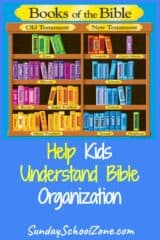Understanding How the Bible Is Organized
 What do we want kids to do while they’re at church? Obviously, we want them to follow the messages, to listen to the messages, and to learn the messages. Seems pretty simple. But listening is easier when you are following along in your Bible, and learning is easier when you are listening. And all of it is impacted to a great deal by a child’s ability to navigate their Bible.
What do we want kids to do while they’re at church? Obviously, we want them to follow the messages, to listen to the messages, and to learn the messages. Seems pretty simple. But listening is easier when you are following along in your Bible, and learning is easier when you are listening. And all of it is impacted to a great deal by a child’s ability to navigate their Bible.
There Is Organization
Telling a child to follow along is pointless if that child has no idea where they are heading. New Testament? Old Testament? What’s that? The Book of Obadiah? Where’s that? Learning your way around the Bible is crucial to being able to learn from the Bible and realizing there is organization to the structure will help. This article will help you understand the Bible’s organization. You can also find help for teaching the Bible’s organization.
So, memorizing the books of the Bible is a great start, but let’s don’t leave kids just with random books in what seems like a random order. Our God is a God of order and the books of the Bible are in an order that makes sense. Knowing and understanding this order can make a lot of difference in our understanding of Scripture.
Two Major Divisions
Most people are aware that the Bible has two major divisions, the first (and largest) is the Old Testament. The Old Testament records the history and writings of Israel in the centuries prior the coming of Jesus. It was written over centuries. The New Testament, by comparison, is smaller (fewer books) and covers a relatively short period of time. The entire New Testament probably was written within a 70 year period or less.
Divisions of the Old Testament Books
The Old Testament consists generally of four types of literature: Law, History, Poetry, and the Prophets. The books of the Bible are typically grouped by these four types, with the prophets being divided into the Major Prophets (they’re larger) and Minor Prophets (they’re smaller).
The Books of the Law (5 books)
The first five books of the Bible are referred to as the Books of the Law because they are generally attributed to Moses and contain the Law of Moses. These book are Genesis, Exodus, Leviticus, Numbers, and Deuteronomy. These books contain a good deal of history (as much as anything) as well as speeches and even songs, so it would be a mistake to imagine these are purely legal documents. It is here we learn about creation, the flood, Babel, the patriarchs, the Exodus from Egypt, Sinai, and the 40 year wilderness wandering.
The Books of History (12 books)
The Books of History begin where the Books of the Law end and include Joshua, Judges, Ruth, 1 & 2 Samuel, 1 & 2 Kings, 1 & 2 Chronicles, Ezra, Nehemiah, and Esther. Here we read about the conquest of the Promised Land, the period of the Judges, the united kingdom, the divided kingdom, the Babylonian captivity and the restoration of the Israelite people to their homeland. It is at this point that Old Testament history essentially comes to a close.
The Books of Poetry (5 books)
The Books of Poetry are so called because of their poetic nature. These books include Job, Psalms, Proverbs, Ecclesiastes, and the Song of Solomon (also called the Song of Songs). These books are distinctly Hebrew and consist of wisdom literature, songs, and narratives.
The Major Prophets (5 books)
Throughout their history, God spoke to His people through prophets. In the Old Testament, the prophets (as a group) weren’t primarily looking to the future. They were most often calling the people to live godly lives NOW. The records of many of these prophets are contained in the prophetic books. Some of the prophetic books are simply longer and, consequently, take up a more “major” portion of the Old Testament. The Major Prophets include Isaiah, Jeremiah, Lamentations, Ezekiel, and Daniel.
The Minor Prophets (12 books)
The smaller prophet books are referred to as the Minor Prophets. Neither their size nor the title of the grouping (“Minor”) should suggest these books are not important. They are merely smaller. These books include Hosea, Joel, Amos, Obadiah, Jonah, Micah, Nahum, Habakkuk, Zephaniah, Haggai, Zechariah, and Malachi.
Divisions of the New Testament Books
The New Testament books can be grouped in different ways, but many identify three broad categories that include history, letters (also called epistles), and prophecy. The historical books include the four Gospels and the Book of Acts. The letters are generally grouped by Paul’s letters and the “General” letters (all the others). The only book labeled as “prophecy” is the Book of Revelation, but just as with Old Testament prophecy, Revelation is not entirely about the future.
The Gospels (4 books)
The four Gospels tell us about the life and ministry of Jesus. They include Matthew, Mark, Luke and John. Each Gospel is written from a different perspective with different purposes, so they each give us different stories, even though they do contain overlapping stories.
The Book of Acts (1 book)
The Book of Acts tells us about the birth and early years of the Church. It helps us understand how the church went from being an exclusively Jewish group of people to being largely Gentile. The Apostle Paul is the primary character in the book, but we also learn about Peter and other early leaders in the church.
Paul’s Letters to the Churches (13 books)
Paul spent much of his life planting churches on several missionary journeys. He later wrote letters to many of the churches and many of these letters have been preserved in the New Testament. Paul’s letters (the Pauline epistles) include Romans, 1 & 2 Corinthians, Galatians, Ephesians, Philippians, Colossians, 1 & 2 Thessalonians, 1 & 2 Timothy, Titus and Philemon.
General Letters to the Church (8 books)
There were also letters written by people like Peter, John, and others. Each letter had a specific audience in mind as well as a reason for the letter. Each letter is, therefore, unique with its own flavor and lessons to be learned. The General Letters (Epistles) include Hebrews, James, 1 & 2 Peter, 1, 2 & 3 John, and Jude.
Prophecy (1 book)
The Book of Revelation is also a letter in that it was written to be delivered to a specific group of churches. It was also intended to encourage Christians in general. The Book of Revelation is prophetic in two ways. Like the prophets of the Old Testament, Revelation spoke to the people living in that day and time. But, Revelation also gives us a glimpse into the future when Jesus ushers in a new age and His kingdom is fully established.
Understanding how the Bible is organized will help anyone better understand the story of the Bible itself as well as how to navigate around the pages of this miraculous book. We hope you will invest the time needed to learn how the Bible is organized and help your children learn it as well!
You can see all of the articles by Sarah on Sunday School Zone.



